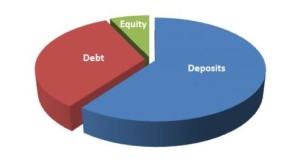Traditionally mortgage lenders would adjust their interest rates in-sync with the Reserve Bank of Australia. They may not have always passed on a full rate cut, but it was uncommon for them to move without the Central Bank announcing any increase or decrease following their monthly meeting.
More recently, the banks have attempted to move away from the expectation that their rates are dependent on the official cash rate. We have seen a much higher incidence in what is referred to as “out of cycle increases.” The explanation for this is found by understanding where banks get their money from to fund loans.
Typically, there are three main sources of funds – deposits, which account for around 60%, short term and long term debt which accounts for around 30-35%, and equity which makes up the remainder.

Deposits
The biggest source of funds, and by far the most profitable, is via savings accounts or term deposits from consumers. Put simply, if you allowed someone to deposit their money and paid them a rate of say 2.50% pa, and then charge someone else 4.00% pa to borrow that same amount of money, it’s easy to see how banks make a profit. The issue facing banks at the moment is the Australian economy is going through a period of relative uncertainty. Years of property price increases have seen household debt increase to 120% of GDP. This means Australians have the highest proportion of personal debt amongst every other country in the G20 (which includes countries such as the US, UK, Canada and much of Europe). Wages growth has been sluggish meaning that people’s take home pay has not increased sufficiently to cover their growing repayments. This in turn leads to less spending which is a key driver in growing the economy, and then finally, less money to put aside into savings which the banks rely on to fund new loans.
Debt
Fewer deposits mean banks are required to find other methods of raising funds which they can then lend out to borrowers. They do this by borrowing money themselves. Banks often lend money to each other to meet their liquidity requirements. It can be for as little as overnight or longer such as a few months. Another way is by accessing financial markets both domestically and offshore. Borrowing costs for both these methods have risen for a number of reasons including a shortfall of funds, as well as a growing US economy and the resultant increases to US interest rates that brings. With higher borrowing costs, banks are faced with two options – absorb the increase which puts pressure on their profits, or pass the increases on to consumers.
Equity
The banks own capital, or equity, makes up a little less than 10% of the funds that it lends out to its customers. The equity in any company belongs to its owners (i.e. the shareholders). Naturally anyone that invests in bank shares demands to see a return on their investment, and indeed, many bank executive’s pay packets are closely tied to their profits. The bottom line is, there is only so long that a bank (or any company for that matter) will allow its returns to be eroded by increasing costs which means if home loan rates need to rise to protect their profit, that’s inevitably what happens.
The good news is that Australian consumers who are unsatisfied with their current situation do have a choice. More and more borrowers are turning to mortgage brokers who account for over half of all home loans being written.
Tower Mortgage Broking are a professional Sydney based mortgage broker. For expert home loan advice on how much you could save on your home loan, contact us today.

